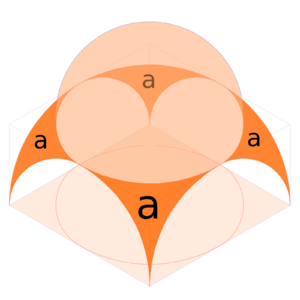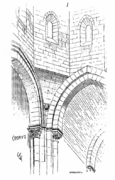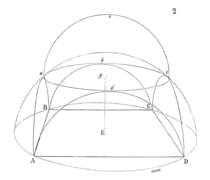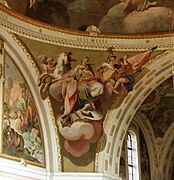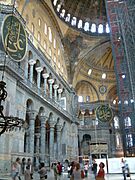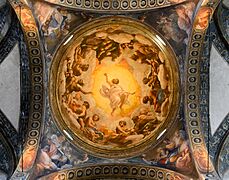Pendentive facts for kids
A pendentive is a clever architectural trick that helps builders put a round or oval dome on top of a square or rectangular room. Imagine trying to balance a ball on a box – it's tricky! Pendentives solve this problem by creating a smooth transition. They are like curved, triangular pieces that connect the corners of the room to the circular base of the dome.
What is a Pendentive?
Pendentives are special parts of a building's structure. They look like curved triangles. They start narrow at the bottom corners of a square room. As they go up, they spread out. This creates a perfect round or oval shape at the top. This new shape is then ready to hold a heavy dome.
Think of it like this: the pendentive takes the weight of the dome. It then sends that weight down to the strong piers or walls at the four corners of the room. This makes the whole structure very stable.
History of Pendentives
Before pendentives were invented, builders used other methods. These included corbelling (stacking stones outwards) or squinches (arches built across the corners). These methods were not as smooth or strong as pendentives.
Architects in the Roman Empire first started experimenting with pendentives around the 2nd or 3rd century AD. However, the design was fully developed much later. This happened in the 6th century in the Byzantine Empire. A great example is the famous Hagia Sophia in Constantinople (modern-day Istanbul).
Pendentives became very popular in churches. You can often see them in Orthodox, Renaissance, and Baroque churches. Sometimes, a tall, round wall called a drum is placed between the pendentives and the dome. This drum often has windows, letting light into the building.
Gallery
-
A pendentive, labelled A, in a church in Nantua.
-
How a pendentive is formed, explained by Eugène Viollet-le-Duc in 1856.
-
Holy Trinity Church, Fulnek, Czech Republic.
-
Church of St. Clement of Ohrid, Skopje, North Macedonia.
-
One pendentive of the Hagia Sophia main dome.
See also
Sources


